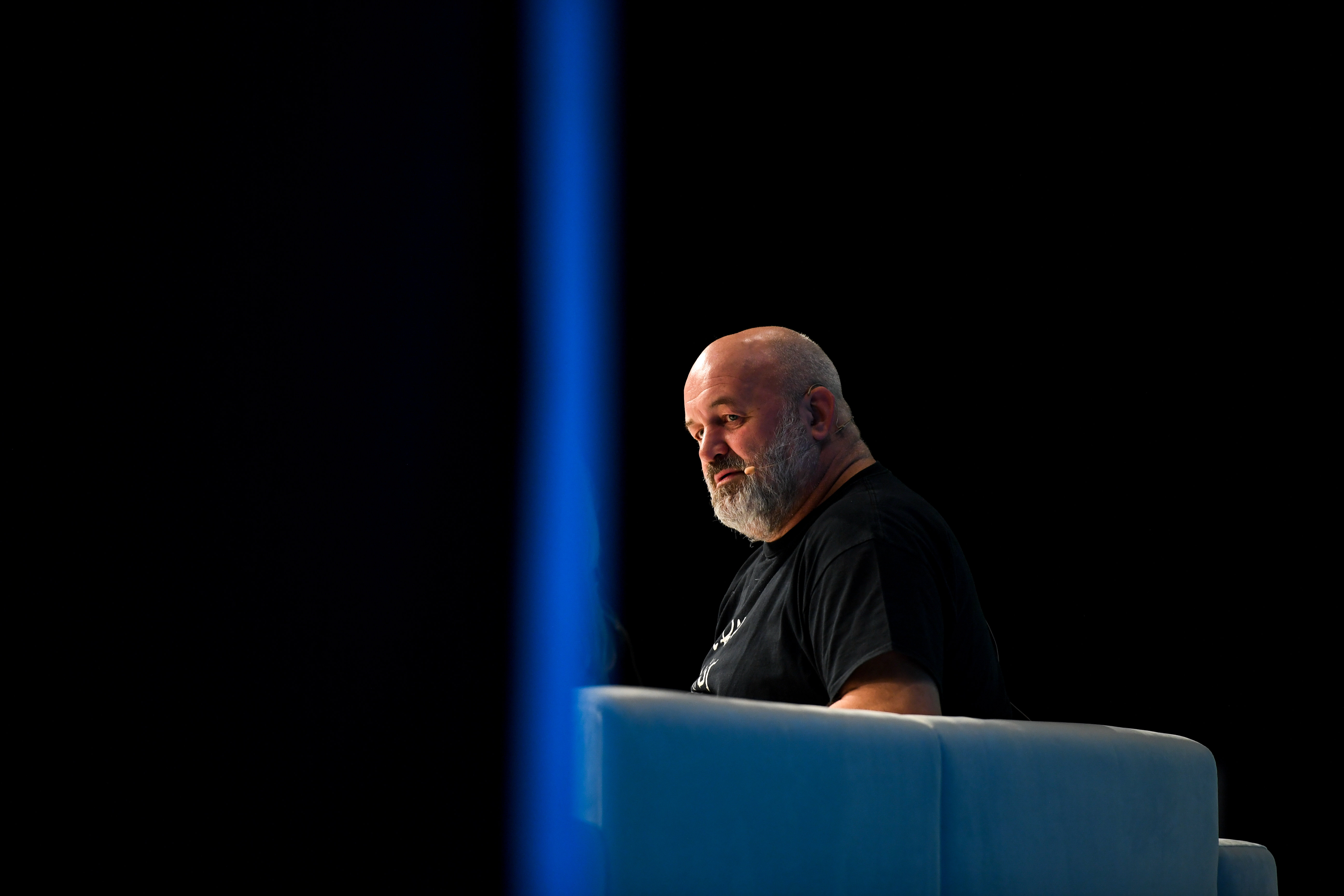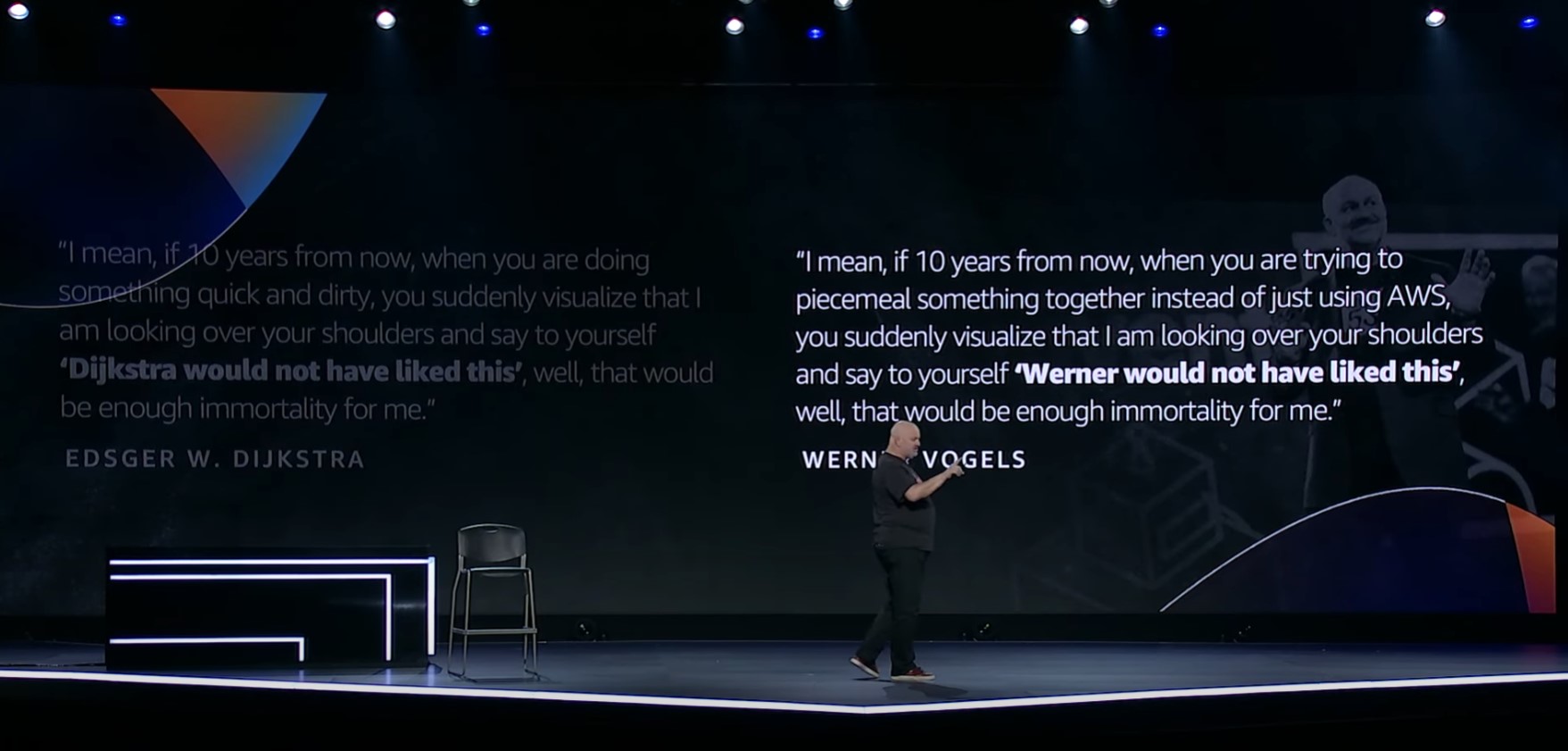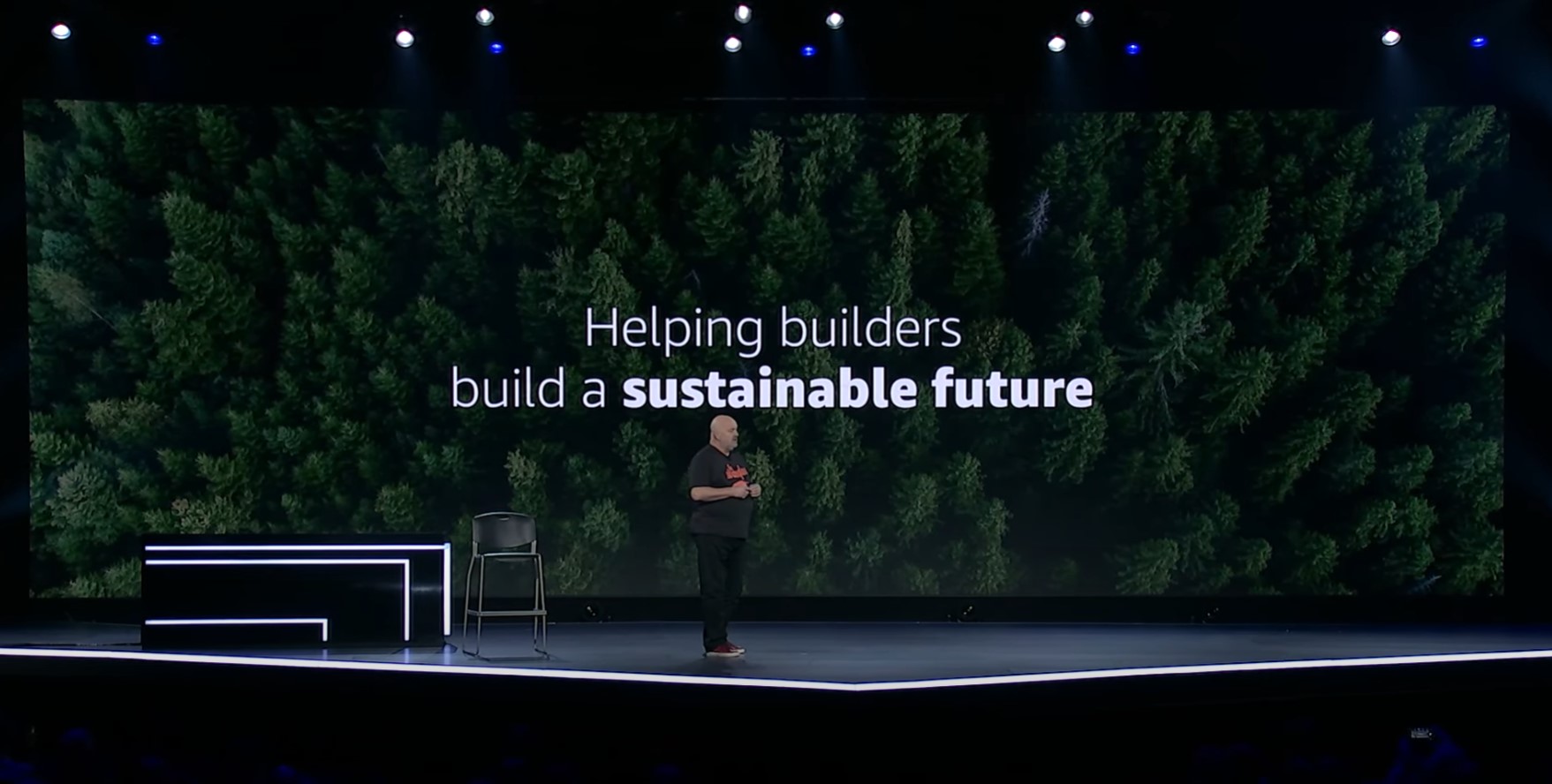Amazon CTO Werner Vogels has been in his job for 16 years, but the 63-year-old isn’t quite ready to retire. “There is so much more to do. I’m not finished yet,” he told me during an interview at the company’s annual re:Invent conference in Las Vegas last week. “We’re having an absolute ball with all the things that we’re doing. […] It’s a dream job.” He noted how the percentage of IT spend that goes to the cloud is still minimal, “and then from a technology side — oh man — there’s so much more in the pipeline, so I’m not going anywhere.”
With re:Invent, Amazon placed a substantial bet on the return to in-person conferences. Typically, the show’s more than 60,000 attendees take over the Las Vegas Strip for a week. This year, there were about 27,000 attendees, which would still make it one of the largest tech conferences in any pre-COVID year, too.
The conference was also the first AWS event with Adam Selipsky at the helm of the organization, with its long-time AWS CEO Andy Jassy now in Jeff Bezos’ CEO role on the retail side of Amazon. Selipsky did not use the event to announce any major changes in AWS’ strategy, as some had hoped. And maybe that’s no surprise. According to Vogels, there haven’t been any major changes under the new leadership yet.
“I knew Adam, of course, for a long time over the years. He joined us in the second year of AWS, maybe the first year, and then went off, of course, to do Tableau — and now he’s back. So that’s good. But, of course, he intimately knows the business,” Vogels said, and also noted that Selipsky and Jassy had long worked closely together before Selipsky took the CEO position at Tableau. “It’s just continuation, just business as usual. Of course, the world around us is changing and I think there’s lots of sensitivities that he definitely has to deal with — and the same goes for AWS. I mean, this is not a business that is sort of riding off into the sunset and resting on laurels and just do nothing. That is a business that continues to innovate and is also innovating itself.”
During his keynote, Vogels noted how AWS now has hundreds of different services. Jokingly, he blamed the company’s customers for that, who keep asking for more. But that’s also becoming a real problem, as it gets harder and harder for businesses to decide which service to use. AWS, Vogels noted, believes in building primitives, not frameworks. “But also, I think we have the chance — and we’ve seen this in the past years — to build more solutions, to build more packaged things for our customers. There is a certain very large builder’s side of AWS that still likes the tweaking and putting things together and things like that, but there’s also a significant portion of our customers that just want a data lake,” he said. And some of those are the internal customers at AWS that take these primitives like AWS Glue, the company’s managed serverless data integration service, to build other solutions (and the feedback cycle from these internal teams, of course, is very fast).
Almost by default, for every service, there’s a long list of new features that users want — and then there’s the development team’s roadmap. Often, Vogels noted, AWS changes that roadmap based on how customers are using a service. With DynamoDB, AWS’s NoSQL key-value database, the team knew customers would want secondary indices. “But we decided to launch without, mostly to understand exactly how customers would start to use these databases. It was already on our roadmap, but customers actually wanted cell- and row-level security much more than secondary indices, so you allow your customers to change your roadmap and I think that’s just a healthier approach,” explained Vogels.
Another kind of customer, Vogels explained, is large, traditional enterprises that are still trying to figure out not just the technological part of moving to the cloud but also everything else around that. How do you build the organizational structure around that. That’s where AWS’s partner network comes in, but more and more, they are also asking AWS for help with these cultural changes directly.

LISBON , PORTUGAL – 7 November 2019; Werner Vogels, CTO, Amazon, on MoneyConf Stage during the final day of Web Summit 2019 at the Altice Arena in Lisbon, Portugal. (Photo By Harry Murphy/Sportsfile for Web Summit via Getty Images)
Five years ago, the main drivers for migrating to the cloud were about developer productivity and moving beyond owning hardware. “These days, the number one [reason] is security,” Vogels noted. “Many organizations — and definitely the larger enterprises — start to realize they cannot protect themselves. They cannot make these kinds of investments, but AWS can make them for them. And as such, it becomes a major driver for transitioning in the cloud.”
That’s quite a difference from only a few years ago, when enterprises still worried quite a bit about security in the cloud and often saw it as a potential hurdle to migrating. Vogels believes that was mostly FUD. “Well, you know, there is just this thing called FUD — fear, uncertainty and doubt — a marketing approach put into the world by your competitors who prefer to actually spread lies and introduce fear and uncertainty in the story instead of working on building better products. I think a very significant portion of this is that all standard IT companies were, ‘really you’re going to buy servers from a bookshop? How crazy can you be? Well, it turns out everybody wants servers from a bookshop. People didn’t realize that Amazon had been a technology company from day one.”
Vogels himself, he said, had a very primitive view of AWS before he joined the company. When the company first invited him to give a talk while he was still an academic, he wasn’t quite sure what to make of Amazon. And indeed, he noted that hiring engineers was actually one of the biggest challenges in the early days of the service. “One glimpse at the kitchen, however, and I realized that anything that was in the distributed systems textbook was happening at Amazon — but at scale, and at a scale that I had never seen before.”
For security in the cloud, people had the same misunderstandings in the early days. And while there’s the genuine kind of misunderstanding that Vogels himself had about the scale of Amazon, he noted that there’s a second kind, too. “There is the mischievous misunderstanding of your competitors,” he said. “I remember one of our competitors who is now a really good partner, in those days, they actually had sales meetings and they said, ‘who would ever want to buy servers from Amazon? It’s ridiculous. Don’t worry about it.’ Things are different now.”
When you talk to large enterprise CIOs, CTOs and other decision-makers, they often talk about wanting to be multi-cloud in order to get the best of what the various hyper clouds have to offer. All of the major cloud vendors, including AWS, now offer one kind of service or another to enable this, using their technology to run and manage containers and services on their competitors’ clouds. In reality, I’m not seeing a lot of companies actually doing this, though, and more and more, I hear companies say that this just locks them into the lowest common denominator. That’s something Vogels also echoed.
“If I would be a CIO of a large enterprise, I would indeed tell my people: ‘go, take a look at all of them.’ The customers I talk to, if they are really interested in multi-cloud, start looking at what are the unique capabilities of a particular cloud that you may want to use. Don’t tell your developers to transparently work over three or four more clouds. Why? Because they go to the lowest common denominator. That means that you’re going to use clouds as a data center, which means you lose all the advantages that you get.”
He argued that customers, just like they would when evaluating any other service, want to have an exit strategy. In practice, that may mean going with a single cloud provider, but architecting a system that would make it easier to move to another cloud if that ever becomes necessary.
For a lot of companies, migrating to the cloud still means lifting and shifting their existing services. Increasingly, though, it also means they can start to look at new development patterns. During his keynote, Vogels put a special emphasis on using serverless patterns, and indeed, he thinks that it should be something of the default going forward. “If you’re building from scratch, then yes,” he said when I asked him about this. But he also noted that there are, in essence, three different compute platforms today: instances, containers and serverless. Your SAP system, you’ll likely move to a specialized instance on EC2. Your homegrown tools that you can decompose into smaller blocks would make a good candidate for containers and Kubernetes. And then, for completely new services, serverless would be a good candidate.
“Interesting enough, I always thought when we launched [AWS’ serverless platform] Lambda, I thought that the young entrepreneurs, the digital guys will be hung-ho over it. It turns out, the biggest users of Lambda became enterprises,” Vogel noted and argued that this is likely because serverless gives them more control over their cost.
He also noted that there is a sustainability argument to be made for serverless, which doesn’t consume any resources while a service is idle. AWS made sustainability the sixth pillar of its well-architected framework last week, as Vogels announced during his keynote. AWS believes in a shared responsibility model for cloud sustainability, with the company planning to run its operations on 100% renewable energy by 2025. But at the same time, it’s also up to the users to figure out how to most efficiently use the cloud, too.
“I try to motivate my customers to start thinking about what they could do and not only think about technology, but what if you have, maybe a website that’s just a little bit less rich? Maybe your images are not five megabytes but maybe just 500K. All these kinds of things. So, become aware of the kinds of things that you are doing in your application design, or your website design, that actually may just use less resources,” he said. In a way, that’s against how engineers are trained to think, but Vogels argues that’s it’s a question of what you optimize for. Maybe a bit of extra latency reduces conversion rates, but it does help you meet your sustainability goals.
“Two or three years down the road, we’ll see many more development practices happening around that and, of course, tools to measure, because you need to know what you are doing,” he said. “But he also noted that it’ll be up to the customers to decide what they want to optimize for: “I’m not going to tell my customers what they should be doing, because I believe that there should be no gatekeepers. People should be able to innovate in any way that they would want to, but they need to become conscious to themselves.”
Looking ahead, one of those technologies that keeps Vogels energized is quantum computing. Earlier this year, AWS announced that it would start building its own quantum hardware, with a bet on superconducting qubits. As of now, the company is partnering with a number of major quantum players, including IonQ, Rigetti and D-Wave, in making their hardware and services available through its Braket service. But clearly, just like Google and Microsoft, AWS believes in building its own quantum hardware, too, just like it does for classical chips.
“I think it’s one of those areas where hardware and software are working lockstep with each other. Improvements in hardware beget improvements in software, software improvements drive the hardware to different improvements. I think, for example, the software tools in and around quantum are nowhere near the software tools we have for classical computation, but for that, we need to start building applications. And so, with Amazon Braket our customers can start investigating. What kind of algorithms [do you use]? How do you do software development for that? How do you track that? How do you do operations around that. All these kinds of things. There is so much more to figure out there that will have an impact on the hardware as well. I’m really looking forward to seeing where we are three years from now.”
And so chances are, barring another global lockdown, we’ll see Vogels take the stage on the last day of re:Invent 2024 and talk about AWS’ latest improvements to its quantum computer and how the developers in the audience can make the best possible use of that.




